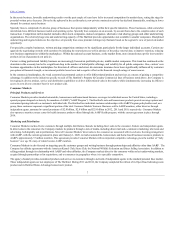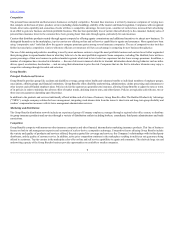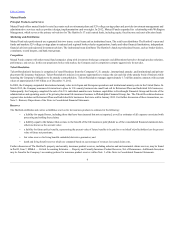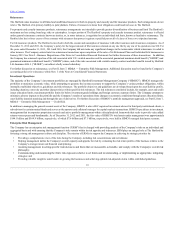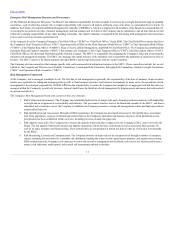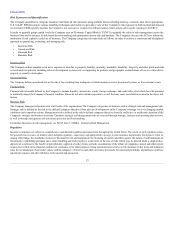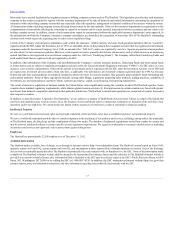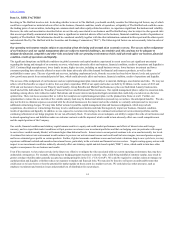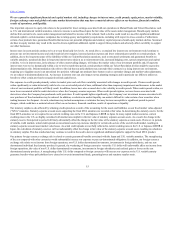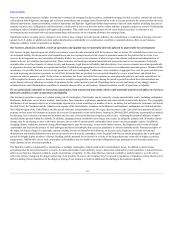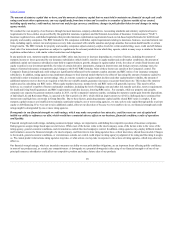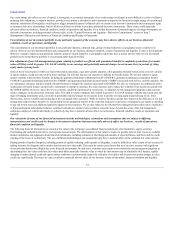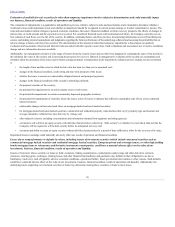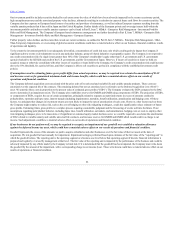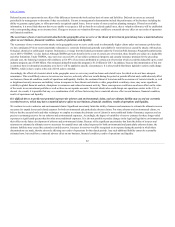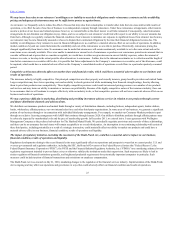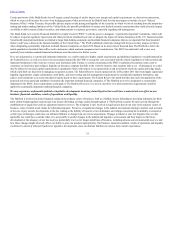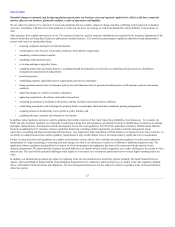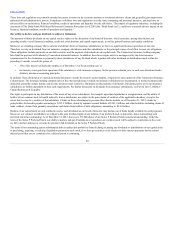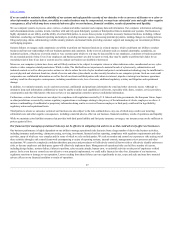The Hartford 2012 Annual Report Download - page 17
Download and view the complete annual report
Please find page 17 of the 2012 The Hartford annual report below. You can navigate through the pages in the report by either clicking on the pages listed below, or by using the keyword search tool below to find specific information within the annual report.
Table of Contents
Actual results could materially differ from the analytical models we use to assist our decision making in key areas such as underwriting, capital,
hedging, reserving, and catastrophe risks, which could have a material adverse effect on our business, financial condition, results of operations
or liquidity.
We employ various modeling techniques (e.g., scenarios, predictive, stochastic and/or forecasting) to analyze and estimate exposures, loss trends and other
risks associated with our assets and liabilities. We use the modeled outputs and related analyses to assist us in decision-making related to underwriting,
pricing, capital allocation, reserving, hedging, reinsurance, and catastrophe risk. Both proprietary and third party models we use incorporate numerous
assumptions and forecasts about the future level and variability of interest rates, capital requirements, loss frequency and severity, currency exchange rates,
policyholder behavior, equity markets and inflation, among others. The modeled outputs and related analyses are subject to the inherent limitations of any
statistical analysis, including the use of historical internal and industry data and assumptions. Consequently, actual results may differ materially from our
modeled results. The profitability and financial condition of the Company substantially depends on the extent to which our actual experience is consistent with
assumptions we use in our models and ultimate model outputs. If, based upon these models or other factors, we misprice our products or our estimates of the
risks we are exposed to prove to be materially inaccurate, our business, financial condition, results of operations or liquidity may be adversely affected.
Our business, financial condition, results of operations and liquidity may be adversely affected by the emergence of unexpected and unintended
claim and coverage issues.
As industry practices and legal, judicial, social and other environmental conditions change, unexpected and unintended issues related to claims and coverage
may emerge. These issues may either extend coverage beyond our underwriting intent or increase the frequency or severity of claims. In some instances, these
changes may not become apparent until some time after we have issued insurance contracts that are affected by the changes. As a result, the full extent of
liability under our insurance contracts may not be known for many years after a contract is issued, and this liability may have a material adverse effect on
our business, financial condition, results of operations and liquidity at the time it becomes known.
As a property and casualty insurer, the premium rates we are able to charge and the profits we are able to obtain are affected by the actions of
state insurance departments that regulate our business, the cyclical nature of the business in which we compete and our ability to adequately price
the risks we underwrite, which may have a material adverse effect on our business, financial condition, results of operations and liquidity.
Pricing adequacy depends on a number of factors, including the ability to obtain regulatory approval for rate changes, proper evaluation of underwriting
risks, the ability to project future loss cost frequency and severity based on historical loss experience adjusted for known trends, our response to rate actions
taken by competitors, and expectations about regulatory and legal developments and expense levels. We seek to price our property and casualty insurance
policies such that insurance premiums and future net investment income earned on premiums received will provide for an acceptable profit in excess of
underwriting expenses and the cost of paying claims.
State insurance departments that regulate us often propose premium rate changes for the benefit of the consumer at the expense of the insurer and may not allow
us to reach targeted levels of profitability. In addition to regulating rates, certain states have enacted laws that require a property and casualty insurer
conducting business in that state to participate in assigned risk plans, reinsurance facilities, joint underwriting associations and other residual market plans,
or to offer coverage to all consumers and often restrict an insurer's ability to charge the price it might otherwise charge or restrict an insurer's ability to offer or
enforce specific policy deductibles. In these markets, we may be compelled to underwrite significant amounts of business at lower than desired rates or accept
additional risk not contemplated in our existing rates, participate in the operating losses of residual market plans or pay assessments to fund operating deficits
of state-sponsored funds, possibly leading to unacceptable returns on equity. The laws and regulations of many states also limit an insurer's ability to
withdraw from one or more lines of insurance in the state, except pursuant to a plan that is approved by the state's insurance department. Additionally, certain
states require insurers to participate in guaranty funds for impaired or insolvent insurance companies. These funds periodically assess losses against all
insurance companies doing business in the state. Any of these factors could have a material adverse effect on our business, financial condition, results of
operations or liquidity.
Additionally, the property and casualty insurance market is historically cyclical, experiencing periods characterized by relatively high levels of price
competition, less restrictive underwriting standards and relatively low premium rates, followed by periods of relatively low levels of competition, more
selective underwriting standards and relatively high premium rates. Prices tend to increase for a particular line of business when insurance carriers have
incurred significant losses in that line of business in the recent past or when the industry as a whole commits less of its capital to writing exposures in that line
of business. Prices tend to decrease when recent loss experience has been favorable or when competition among insurance carriers increases. In all of our
property and casualty insurance product lines and states, there is a risk that the premium we charge may ultimately prove to be inadequate as reported losses
emerge. In addition, there is a risk that regulatory constraints, price competition or incorrect pricing assumptions could prevent us from achieving targeted
returns. Inadequate pricing could have a material adverse effect on our results of operations.
17


